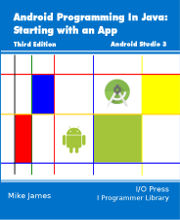| Android Adventures - Spinners |
| Written by Mike James | ||||
| Friday, 21 August 2015 | ||||
Page 3 of 3
ArrayAdapter From ResourceTo create an ArrayAdapter from a resource you need to make use of a static method of the ArrayAdapter class - createFromResource. This just needs you to specify the context, the resource id and the Spinner layout. All you have to do is to replace the creation of stringArrayAdapter
With this change everything works as before but now to change the items that appear in the Spinner you simply edit the XML file. You could also use the getResources object to retrieve the String array and then proceed as if the String array had been defined in code.
Changing The ListThere are lots of more advanced things that you can do with Spinners but these aren't encountered that often - mainly when trying to build a custom user experience. The one thing that does occur often is the need to dynamically change the list of items. There are many slight variations on this but essentially what you can do is change the String array and then call the adapter's notifyDataSetChange method. For example if you want to change Mexico, i.e. element one, to Greenland you would use:
The ArrayAdapter also has an add, clear, remove and an insert method which can be used to modify the underlying data but for this to work the object holding the data has to be modifiable. You can't modify a String array in this way. What you need is an ArrayList. If you change the declaration of country to:
You can then add "Greenland" to the end of the items using:
You can always find out how many items there are using the getCount method. Notice that in this case the ArrayAdapter constructor used changes from one that accepts an array to one that accepts a List of objects. How do you modify a list of items that are created using a resource? This is a tricky question because the ArrayAdapter creates a String array to hold the data which means you can't use the methods that modify a list. There are a number of ways of fixing this up but the simplest is perhaps to construct your own ArrayList from the resource directly:
With this version of the ArrayAdapter you can once again use the add and other methods to modify the list of items. Summary
ConclusionThere is much more to say about the Spinner and how to customize it, but the methods explained here are the most common. If you don't agree email me with a question. Moving on from Spinners the next thing you need to know about are Pickers, the topic of the next chapter. Meanwhile if you have any questions on what we've covered so far please let me know using the comments.
You can download the code for this program from the CodeBin. (Note: you have to register first).
 |
||||
| Last Updated ( Thursday, 13 October 2016 ) |


